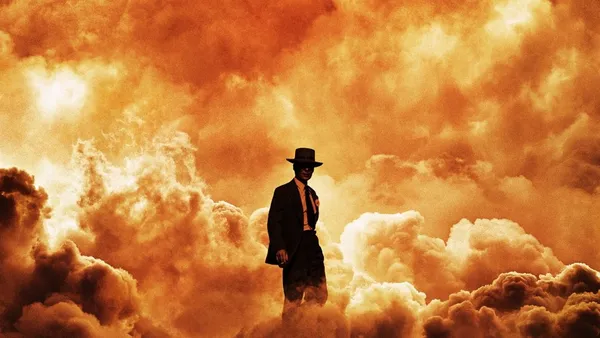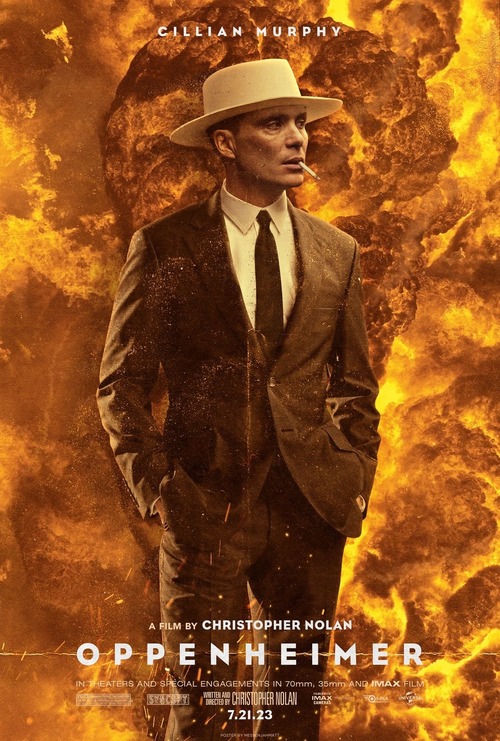Eye For Film >> Movies >> Oppenheimer (2023) Film Review
Oppenheimer
Reviewed by: Andrew Robertson

Fission, a process by which one thing becomes more than one. Fusion, a process by which more than one thing becomes one. Both had meanings before they were adopted by nuclear physics, but in its atomic narrative Oppenheimer is built from two strands, each named for one of those processes. Fission, in colour, itself divergent. Fusion, in black and white, itself convergent. Christopher Nolan adapts for the screen a tale that gives him the chance to exercise his particular fondnesses, for large format film and its chemistry, for stories that loop around one another in uncertainty until certain elements are observed, for small things with large impacts.
Fission, centred on Oppenheimer himself, Cillian Murphy always recognisable in more than one era. Luisa Abel (a frequent Nolan collaborator) and her team can't quite make Murphy look as young as his subject in some spaces nor as old as his prototype in others but there is enough to indicate intent, to suggest, to support. That is one of several spaces where the film feels not stagey but staged. Often, very often, various men in various rooms talking.

Staging in filmmaking fundamentals like blocking and focus. Various scaffolds, the execution of plans by planners. Structure, and structures. The film establishing rules for its two main elements. See Heisenberg, the uncertainty. In the quantum of explanation that light can be both particle and wave. Whenever you see someone with a bit of the periodic table named after them you could have a drink but that would be unwise.
Fusion, centred on Oppenheimer's opposite, Robert Downey Jr exercising acting muscles one might have feared withered by mechanical marvels. Lewis Strauss, not noted here for coining the phrase "too cheap to meter," is a man with power. When we say opposite, though, we are in a complicated realm of symmetries. The opposite of a proton is an electron, but as Oppenheimer suspected the opposite of an electron is a positron. That is a solution to an equation of Paul Dirac (Ryan Stubo) and the thing about equations is that they have things on each side.
What sides? Most of them. Two sides of the Park. New York's Central, that is, experience of European Jewish immigration and the class distinctions between German-speaking and Eastern European that persisted. Urban and rural. Oppenheimer at one point described as Mayor and Sheriff. Military and civilian. Oppenheimer again, with many hats. Various sets of us and them. He and she. And she. And he. Even various sets of US, one sequence with the wrong flag is another where stars are important, perception, memory. Stars too, the ones that shine and can be seen and the ones predicted. The mathematics that informed the prediction of black holes came from one of these classrooms. Those 'them' though, various. Honeymoons in one place, learning in another. It's not an accident that the only person we hear from who spent time on (now) Soviet soil did so to spill Bolshevik blood. When they say "give it back to the Indians" there's information in that lack of detail. Others too, sex and its opposites, what it is to be intimate, to be naked, to be exposed. You don't see them telling Kodak about the bomb because films across the region showed the bloom of particulate passage afterwards, but you do see other marks on other paper indicating others had been experimenting too.
There are ten thousand eight hundred and nine seconds of Oppenheimer and there are several small stretches of them that matter. Maybe all of them, however important or unimportant they might seem. God might play dice, but Nolan is a watchmaker. All these components hurtling around each other in their orbits representing something that they participate in, defining and describing function. Time another one of those components of physics where the closer one gets the bigger things seem until they become so large that they can be abstracted away. Maybe 40 years. Maybe a few minutes. Maybe a moment. Maybe forever. There are arguments as to whether films are getting longer but the sweep of Nolan's ambition needs that canvas. Needs that count-down.
There are several explosions. Enough to make it clear that these are large enough and from sufficient distance that seeing them and hearing them are not the same. Light emitted sprinting as fast as is allowed towards observer while sluggish matter struggles in its wake. Light imagined spinning as fast as is imagined from Oppenheimer while sluggish flesh struggles still awake. Some are physical, several emotional. An apple made toxic in the real becomes differently allegorical. Even the difference between injection and submersion are part of the pairs of fruits of poisonous trees.
Opposite Oppenheimer wife Kitty (Emily Blunt) and her opposite Jean Tatlock (Florence Pugh) and the four of them, Murphy, Downey, Blunt, Pugh deserving of plaudits for performance. There's a tendency at times to complain about sex scenes but nudity tells us something. Often it's little more than that someone has no clothes on, but that tells us something too. Under it all we are all naked. Any scene has to justify itself, to tell us something about the characters involved, about events. That staging again, three of them not in one place and a fourth telling a different story matters. Seeing where the minute hand is tells us what the hour hand means. Even if it's wrong.
A lie prompts other lies. A cascade, increasingly energetic. As with neutrons to the neutral, a critical mass. Information accumulates and sheds new light in new ways. Keep everything bottled up in one place. Shake the jar.
There are jokes that Nolan's commitment to realism would see him commission an actual atomic device. We do see into the atomic, special effects. In sound and vision tone, tone throughout. A composition, a poem. An ode, an odyssey. We hear the atomic, Ludwig Goransson building on the bombast of Tenet. Hoyte Van Hoytema returns to Nolan too, also working on Dunkirk and Interstellar.
As with those four, and the Nolans that don't feature Bat-man, Nolan's particular habits. Narratives that rely on different time signatures, that are in opposition or are rapidly recontextualised by revelation, even within themselves. Craft: actual, physical, palpable craft. Performance and paintwork, treading the boards and sanding them too. One recurrent noise is not a train but applause, and all the more terrible for it. The Prestige invented the terms it uses for the phases of a magic trick. The last comes from Christopher Priest's novel, but 'setup' became 'pledge' and 'performance' became 'the turn'. I'm not so resistant to alliteration.
That discussion is the key to that film. There's always a key. From the off when it explains its one and its two, its fission and its fusion. How those impose and super-impose views of the world, of the same events. Within them flashbacks, recollections, retellings within the retellings until it's tattle all the way down. Asteroid City is as artificial in places in its pursuit of the real, and Oppenheimer is as artificial in places in its pursuit of its real. These are the halls, the walls, the paintings, the portraits, the rigging and the platforms, the curtains and the calls. These are the clouds of probability made mathematical certainty, the interactions of dissimilar forces.
As Wes Anderson's latest is inescapably defined by how he works and who he works with so is Nolan's, another in an array of opposition and reflection and symmetry of form and function, of habit and repute. In being a Nolan film it's got those weaknesses of characterisation for women, in being a historical record it's got the usual compromises around the clouding of truth, and for some these points of diffraction will be grating. These observations might matter to some but they are not new complaints. That they've not been entirely addressed is worth noting but continuing the same but different has thematic weight. Detail again. In mentioning, but not examining, there's still something being said. This is how easy it is to change a life. A stroke of a pen. A marble in a jar. To gaze, however filtered. To bring the sheets in. To push a button.
There's always a line in a Nolan film, a point where the vapour of nuance condenses to the certainty of fact. "You don't get to commit sin and get people to feel sorry for you". Even the number of words might have meaning, freighted, fated. There's detail everywhere, but sometimes, like the flags, it might raise vexing questions.
Does it matter that it's two trucks and not the rest of the convoy with its carloads of soldiers? Not when the focus is on pairs. Does it matter that there are 50 stars on some flags and not others? Not when that's memory, perhaps. Not when that's a pair too, one Russian, one Pacific, one bought, one stolen. Does it matter that there are dozens in a cast giving tremendous performances that'll be reduced to Blunt, Downey, Murphy, Pugh? I've done it too. Two by two. Does it matter that it's three overwhelming hours, staged enough that one wishes they'd managed an intermission? Does that matter in an age where cinema continues to change, that film and movies and the other words I've used in this sentence alone each create different pictures that work in different ways to describe the same thing? Imagined is not remembered. Neither is reliable. Nolan might be though, as here. History might be written by the victors, but that leaves room for the triumph to be the telling. Oppenheimer is one, if not both.
Reviewed on: 28 Jul 2023


















